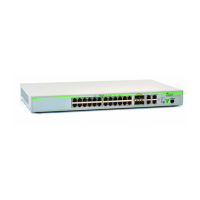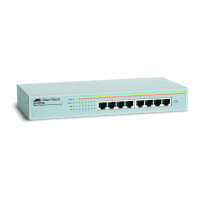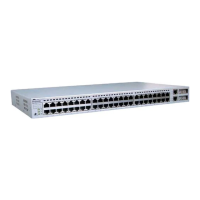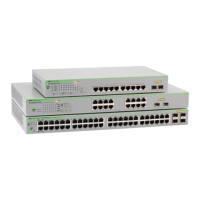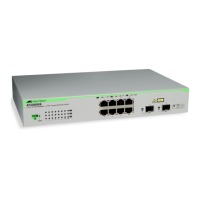Layer 2 Switching 75
Software Release 2.6.1
C613-02025-00 REV C
Devices that are members of the same VLAN only exchange data with each
other through the switch’s switching capabilities. To exchange data between
devices in separate VLANs, the switch’s routing capabilities are used. The
switch passes VLAN status information, indicating whether a VLAN is up or
down, to the Internet Protocol (IP) module. IP uses this information to
determine route availability.
The switch has a maximum of 255 VLANs, ranging from a VLAN identifier
(VID) of 1 to 4094. When the switch is first powered up, a “default” VLAN is
created and all ports are added to it. In this initial unconfigured state, the
switch will broadcast all the packets it receives to the default VLAN. This
VLAN has a VID of 1 and an interface name of vlan1. It cannot be deleted, and
ports can only be removed from it if they also belong to at least one other
VLAN. The default VLAN cannot be added to any STP, but always belongs to
the default STP. If all the devices on the physical LAN are to belong to the same
logical LAN, that is, the same broadcast domain, then the default settings will
be acceptable, and no additional VLAN configuration is required.
VLAN Tagging
An Ethernet packet can contain a VLAN tag, with fields that specify VLAN
membership and user priority. The VLAN tag is described in IEEE Standard
802.3ac, and is four octets that can be inserted between the Source Address and
the Type/Length fields in the Ethernet packet (Figure 14 on page 76). To
accommodate the tag, Standard 802.3ac also increased the maximum allowable
length for an Ethernet frame to 1522 octets (the minimum size is 64 octets).
IEEE Standard 802.1Q specifies how the data in the VLAN tag is used to switch
frames. VLAN-aware devices are able to add the VLAN tag to the packet
header. VLAN-unaware devices cannot set or read the VLAN tag.
Table 9 on page 75 lists the meaning and use of the fields in the Ethernet frame.
Figure 14 on page 76 shows the format of VLAN data in an Ethernet frame.
Twelve bits of the tag are the VLAN Identifier (VID), which indicates the
VLAN that the packet belongs to. Table 10 on page 76 lists the VLAN Identifier
values that have specific meaning.
Table 9: Fields in the Ethernet frame for QoS and VLAN switching.
Field Length Meaning and use
TPID 2 octets The Tag Protocol Identifier (TPID) is defined by IEEE Standard
802.1Q as 0x81-00.
User Priority 3 bits The User Priority field is the priority tag for the frame, which
can be used by the switch to determine the Quality of
Service to apply to the frame. The three bit binary number
represents eight priority levels, 0 to 7.
CFI 1 bit The Canonical Format Indicator (CFI flag) is used to indicate
whether all MAC address information that may be present
in the MAC data carried by the frame is in canonical format.
VID 12 bits The VLAN Identifier (VID) field uniquely identifies the VLAN
to which the frame belongs.
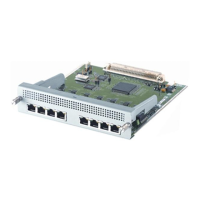
